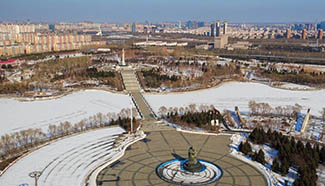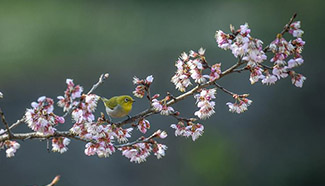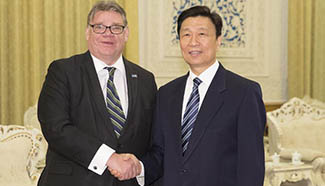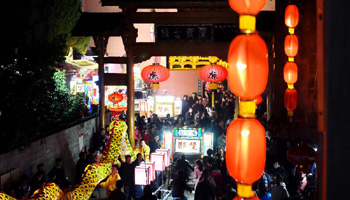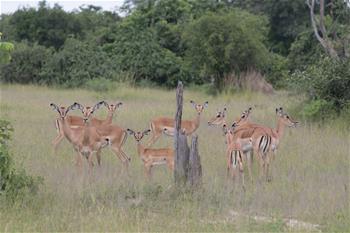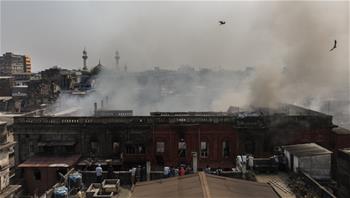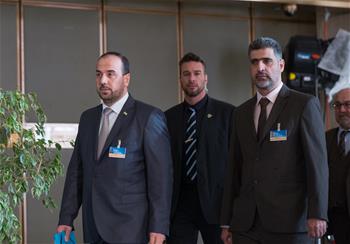
A zebra passes through an animal passage of the Standard Gauge Railway (SGR) near Voi, Kenya, Feb. 22, 2017. Kenya's Tsavo National Park is the oldest and largest wildlife sanctuary in the African country. In the park, the China-funded Standard Gauge Railway snakes throughout an estimated 133-km stretch of plains. Thanks to engineering prowess and environmental consciousness from China Road and Bridge Corporation (CRBC), the SGR's contractor, the modern railway line has not diluted the pristine allure of the Tsavo National Park, contrary to fears voiced by some skeptics. (Xinhua/Sun Ruibo)
by Christine Lagat, Lu Duobao
TSAVO, Kenya, Feb. 27 (Xinhua) -- The sight of elephants foraging unperturbedly in the idyllic scrublands of Kenya's Tsavo National Park could provide a perfect background for shooting a timeless motion picture.
The oldest and largest wildlife sanctuary in the African country is a prized destination for anyone in search of tranquility owing to its vast repository of flora and fauna.
In the park, the China-funded Standard Gauge Railway (SGR) snakes through an estimated 133-km stretch of plains covered by shrubs, small hills and temporary water points.
The SGR will connect the Kenyan capital city of Nairobi and Mombasa, the historic port of the ancient Maritime Silk Road and now an important node of the China-proposed Belt and Road Initiative in East Africa.
Thanks to engineering prowess and environmental consciousness from China Road and Bridge Corporation (CRBC), the SGR's contractor, the modern railway line has not diluted the pristine allure of the Tsavo National Park, contrary to fears voiced by some skeptics.
Along the track, wide underpasses have been installed at short intervals to facilitate the movement of small and large wild animals. The CRBC has also erected a fence on both sides of the track to keep wild animals at bay.
Inside one of the culverts established by the Chinese company, large footprints of lions and small herbivores could be seen everywhere.
Kenyan conservationists have hailed efforts by the CRBC to limit ecological harm to the Tsavo National Park as a result of passage of the SGR project.
Benson Okita Ouma, the head of monitoring at Save the Elephants, a conservation lobby group, said the crossing of the railway through the national park should not be a cause for alarm since the contractor has adhered to globally acclaimed environmental safeguards.
"Both the fence and underpasses in Tsavo east and west national park have effectively facilitated movement of wild animals as they look for fodder and water," he told Xinhua.
The fence erected by the CRBC straddles a critical wildlife corridor in the Tsavo West National Park as evidenced by footprints from carnivores and dung from large mammals.
Ouma said the fence will ensure that there will be minimal disturbance on wildlife treasures inside the park when the SGR commences operations in June this year.
"The embankment on both sides of the railway track alongside underpasses was the right thing to do in order to protect wildlife from harm," he added.
In March last year, Save the Elephants initiated a project in conjunction with Kenya Wildlife Service (KWS) to monitor the movement of elephants at sections of the Tsavo National Park where the SGR passes through.
Ouma said the project involved collaring of elephants to enable them to transmit data that would later be analyzed to ascertain how often they used the underpasses inside the park.
"Preliminary findings revealed that animals were making good use of some underpasses while others were still crossing over the railway," he said, adding that elephants, dikdiks and lions passed through underpasses more often than other wild animals.
Moreover, he said, the fence will prevent animals from climbing over the SGR to enhance their safety and that of commuters who are likely to ply Nairobi-Mombasa route using the high speed train.
Kenyans are optimistic about the SGR project, which is a critical component of the country's development blueprint and will unleash massive economic and social benefits.
The SGR project is also part of the Belt and Road Initiative envisioned by Chinese leaders to revive ancient trade routes linking the Asian giant with vast swathes of Africa, the Middle East and Europe.
As the SGR project snakes through a sizeable stretch of Kenya's largest wildlife sanctuary, local officials said its benefits far outweighs any perceived ecological threat.
Shadrack Ngene, assistant director in charge of ecological monitoring at KWS, said Kenya has sound legal safeguards to ensure that infrastructure development does not threaten habitats.
"Right now, we cannot predict any harm that the SGR project might inflict on Tsavo ecosystem since the contractor put adequate safeguards in place to mitigate threats to wildlife," Ngene said.
The Belt and Road Initiative refers to the initiative on the construction of the Silk Road Economic Belt and the 21st Century Maritime Silk Road. Proposed by China in 2013, it aims to build a trade and infrastructure network connecting Asia with Europe and Africa along the ancient Silk Road trade routes. It has won support from over 100 countries and international organizations.



